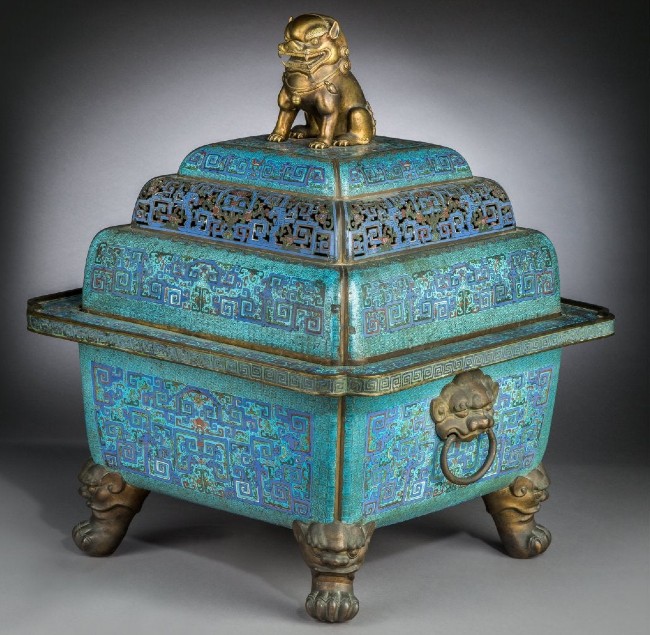
DALLAS – A large and rare Chinese Imperial cloisonné and gilt bronze censer and cover, Qing Dynasty, 18th century could bring $150,000 or more in Heritage Auctions’ Asian Art Auction June 25. Bid absentee or live online through LiveAuctioneers.
The lot (estimate: $100,000-$150,000) comes from the collection of Henry C. Gibson, a 19th-century banker, financier and land owner who served as director and vice president of the Pennsylvania Academy of Fine Arts, the institution that housed his international collection after his death. Censers like the offered lot are closely associated with enameling techniques mastered at the imperial workshop in the southern Chinese city of Guangzhou.
“Large cloisonné and bronze censers of various forms are associated with the vast temples and chambers of Beijing’s Forbidden City,” said Clementine Chen, Heritage Auctions’ Asian Fine & Decorative Art Consignment director. “This large cloisonné enamel censer, from Gibson’s extensive collection of Imperial Chinese works of art, is believed to have been acquired in Europe in the second half of the 19th century. A similar censer, from a collection then housed at the Palace of the Tuileries and presently displayed at the Chateau de Fontainebleau’s Musée Chinois, was among several imperial Chinese artifacts shown in the Illustrated London News in 1861.”
A set of four large Chinese carved zitan armchairs, Qing Dynasty, 19th century (estimate: $80,000-$120,000) has been held in a private collection for the past 30 years and is the first of its kind offered in the United States in the last 10 years. Zitan wood was the most expensive and highly esteemed timber available for the master craftsmen of the imperial workshops in the Forbidden City, shipped from such distant locales as the jungles of Sumatra and Borneo. Because it was reserved for exclusive use by the Ming and Qing imperial courts, and with its limited availability, the use of Zitan was monitored and restricted even within the imperial workshops. At the time these chairs were made, the emperor Yongzheng and Qianlong lavishly funded the works of the imperial workshop, resulting in some of the most highly prized Chinese works of art. Each of these chairs is carved with auspicious motifs, including a bat symbolizing happiness and ruyi symbolizing the attainment of wishes.
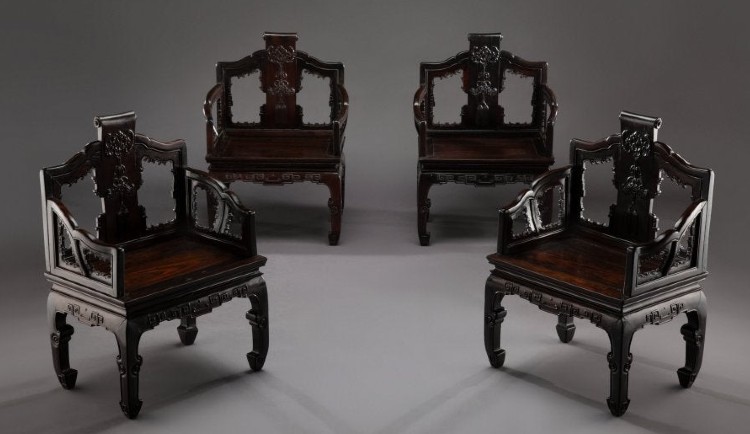
An octagonal Chinese cloisonné octagonal box, Ming Dynasty (estimate: $30,000-$50,000) is comparable to a Ming Dynasty octagonal cloisonné covered box in the collection of Les Arts Décoratifs-musée des Arts décoratifs, Louvre Museum west wing, Paris. Cloisonné objects also are called “Jingtai Lan,” which refers to the reign of Ming Dynasty Jingtai Emperor (1450-57), Xuande’s son, and the period most strongly associated with imperial production of cloisonné. Most collectors consider this period as the absolute height of Chinese cloisonné production in terms of innovation in form and enhancements in color palette. The cloisonné enamel technique was most likely introduced into China from the Byzantine Empire during Yuan dynasty (1279–1368). Chinese artisans further enhanced this technique and Cloisonné objects, with its kaleidoscopic splendor, began to adorn the structures of temples and palaces. By the reign of Emperor Xuande (1426-36), this ware was greatly prized at court and among the households of the government elite. The earliest cloisonné objects with imperial seal date to this period.
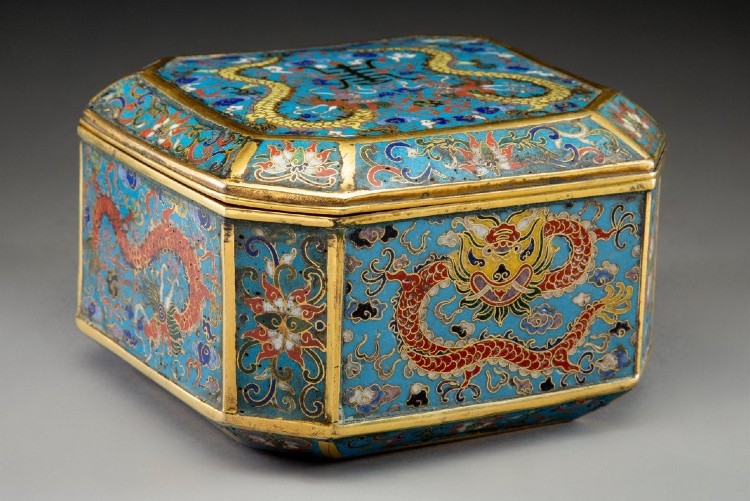
A Pair of Chinese cloisonné fishbowls mounted as floor censers on carved hardwood bases, Ming-Qing Dynasty (estimate: $30,000-$50,000) feature a four-character mark of Kangxi, the reign name of the second emperor of the Qing (Manchu) dynasty who reigned from 1661-1722. Each of the fishbowls stands 29 inches high with its cover but without its hardwood base and has a diameter of 19 inches. The compressed globular body is elaborately decorated with birds, ducks and butterflies in a lotus pond, together with other exotic flowers. The domed cover is surmounted by a gilt elephant finial. The combination of an elephant carrying a vase on its back represents the rebus taiping youxiang: “When there is peach, there are signs.”
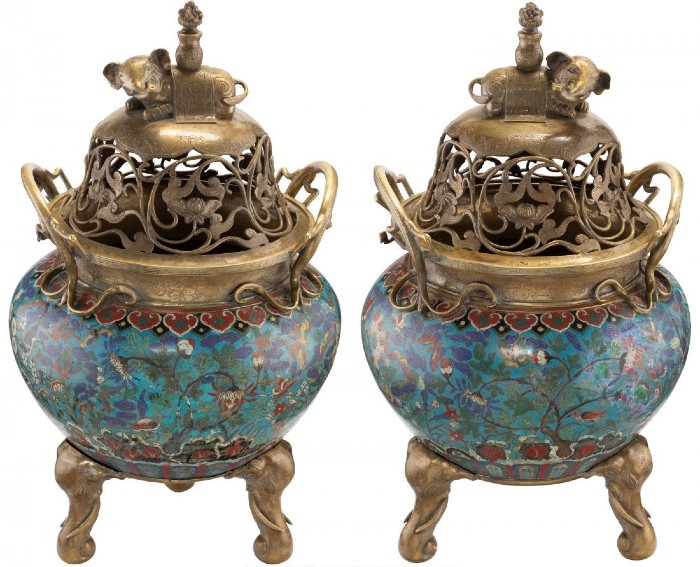
Zhang Daqian pine tree, May 1958 (estimate: $60,000-$80,000) is a beautiful hanging scroll, created in ink and color on paper by one of the best-known and most prodigious Chinese artists of the 20th century. Measuring 71 inches high by 37¾ inches wide, the scroll is signed and dated, with two seals of the artist and one collection seal.
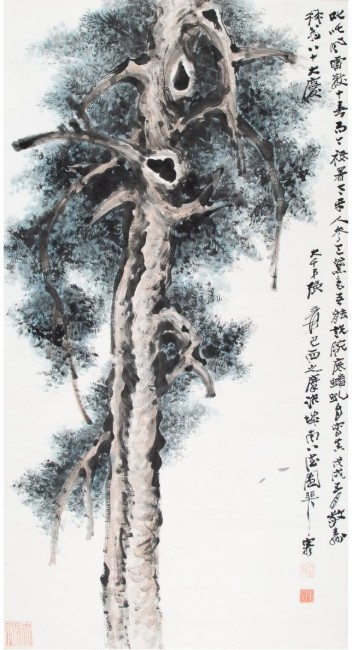
Other top lots include:
– An important South Indian copper alloy standing figure of a Digambara Jina, ninth century (estimate: $30,000-$50,000).
– A pair of Chinese cloisonné and gilt metal revolving vases, Qing Dynasty, 19th century (estimate: $25,000-$35,000).
– A large Chinese cast-iron head of Buddha Vairocana, Yuan Dynasty-Ming Dynasty (estimate: $20,000-$40,000).
– Toshusai Sharaku The Actor Nakayama Tomisaburô as ‘Miyagino’, Edo period, 1794 (estimate: $20,000-$30,000).
– Toshusai Sharaku The Actor Matsumo Koshiro IV as ‘Sakanaya Gorobe-e,’ Edo period, 1794 (estimate: $20,000-$30,000).
– A pair of Chinese cloisonné and gilt bronze dragon-form candelabra (estimate: $20,000-$30,000).
– A pair of Chinese coral-ground porcelain bamboo bowls, Qing Dynasty, Daoguang Period (estimate: $20,000-$30,000).
[av_button label=’View the fully illustrated catalog and bid on LiveAuctioneers.’ link=’manually,https://www.liveauctioneers.com/catalog/170437_fine-and-decorative-asian-art-8001/’ link_target=’_blank’ size=’medium’ position=’center’ label_display=” title_attr=” icon_select=’no’ icon=’ue800′ font=’entypo-fontello’ color=’theme-color’ custom_bg=’#444444′ custom_font=’#ffffff’ av_uid=’av-69ojpso’ id=” custom_class=” admin_preview_bg=”]
View top auction results on LiveAuctioneers here: https://www.liveauctioneers.com/pages/recent-auction-sales/


